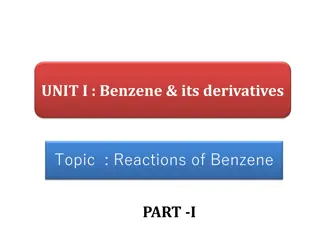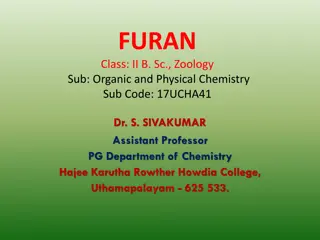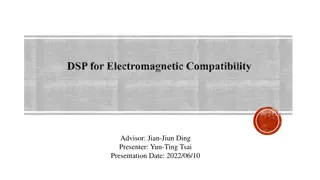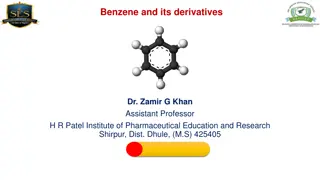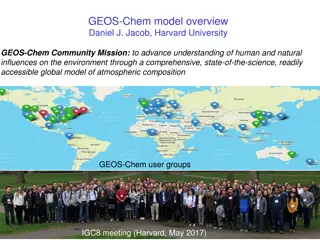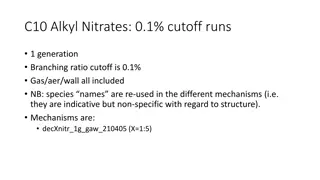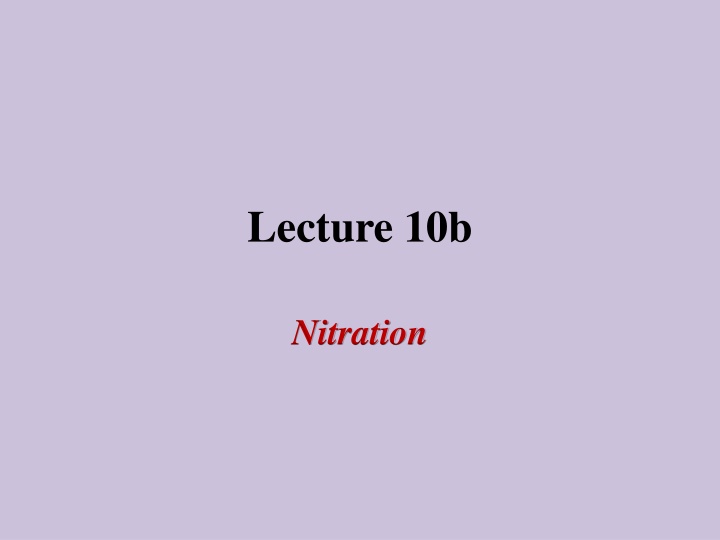
Nitration Reactions in Aromatic Systems
Aromatic nitration involves electrophilic aromatic substitution (EAS), where the product distribution is influenced by various factors such as substituent effects, steric hindrance, and electrophile size. Different substituents direct nitration to ortho, meta, or para positions based on inductive and resonance effects. Electrophiles like nitronium ion are key in nitration reactions, with product outcomes determined by the activating or deactivating nature of substituents present. This summary provides insights into the theory and mechanisms involved in nitration reactions on aromatic systems.
Download Presentation

Please find below an Image/Link to download the presentation.
The content on the website is provided AS IS for your information and personal use only. It may not be sold, licensed, or shared on other websites without obtaining consent from the author. If you encounter any issues during the download, it is possible that the publisher has removed the file from their server.
You are allowed to download the files provided on this website for personal or commercial use, subject to the condition that they are used lawfully. All files are the property of their respective owners.
The content on the website is provided AS IS for your information and personal use only. It may not be sold, licensed, or shared on other websites without obtaining consent from the author.
E N D
Presentation Transcript
Lecture 10b Nitration
Theory I The nitration of aromatic systems is an example of an electrophilic aromatic substitution (EAS). Statistically, an EAS on a mono-substituted arene should afford 40 % of the ortho (two positions), 40 % of the meta (two positions) and 20 % of the para (one position) product. The observed product distributions in EAS look very different i.e., nitration reactions for mono-substituted benzene rings. 100% Substituent ortho meta para 90% 80% 33 % 5 % 62 % CH3 OCH3 NO2 CHO 70% 60% 43 % 1 % 56 % Ortho 50% Meta 6 % 93 % 1 % 40% Para 30% 19 % 72 % 9 % 20% 10% 1 % 50 % 49 % NH2 0% CH3 OCH3 NO2 CHO NH2
Theory II Substituents can be categorized into three groups: Inductive Effect positive negative negative Resonance Effect positive positive negative Activity in EAS Direction Examples high ortho/para OR, NR2, CR3, O(C=O)R F, Cl, Br, I, NO low ortho/para very low meta NO2, COR, CF3, CN Among ortho/para directing substituents, an additional steric effect has to be considered when predicting the product distribution: Alarger substituent on the ring causes the increased formation of the para isomer i.e., methyl (58:37), isopropyl (30:62), tert.-butyl (16:73) in nitration reactions. A larger electrophile also favors the para position i.e., sulfonation (99 %, V=50 3) and bromination (87 %, V=29 3) affords more para product than chlorination (55 %, V=24 3) and nitration (70 %, V=30 3) in the reaction with chlorobenzene. Size does not always favor para-substitution: the nitration of fluorobenzene affords 88 % of the para-product while the nitration of iodobenzene yields only 60 % of the para-product despite the larger size of the substituent. Why?
Theory III Electron-donating substituents, mostly bonded via heteroatoms with lone pairs, are ortho/para directing because the additional resonance structure contributes significantly to the stabilization of the positive charge Electron-withdrawing substituents favor meta addition in order to avoid the concentration of the positive charges on the ipso-carbon + XR XR XR XR XR E E E E + E+ H H H H + ortho + X=O,N,S,P E+ XR XR XR meta + + E E E para + H H H E+ + XR XR XR XR + + + E E E H E H H H X=O,N,S,P
Theory IV If both types of groups are present, the strongest activating substituent will win out over weakly activating or a deactivating substituent when it comes to the directing effect. H2SO4/HNO3 25 oC 99%
Nitration I The nitration reaction uses the nitronium ion (NO2+) as electrophile Sources (mostly in-situ) Diluted or concentrated HNO3 Mixture of concentrated HNO3 and concentrated H2SO4 N2O5 in CCl4 (NO2+ + NO3-) (Note: N2O5 is made from NO2 and O3 While NO2 is a brown gas, N2O5 forms a white solid!) KNO3/H2SO4 in CH2Cl2 Nitronium salts (NO2+BF4-, NO2+PF6-, unfortunately they do not dissolve well in organic solvents) Metal nitrates (i.e., calcium nitrate, iron(III) nitrate) with acetic acid The nitronium ion is a very strong electrophile because only one resonance form with positive charge mostly on the nitrogen atom (red=negative charge, blue=positive charge) The calculated bond order for the NO bond is 1.84 (HF/6-31G**) which is close to a double bond. The nitrogen atom almost bears a full positive charge.
Nitration II Because methyl benzoate is an electron deficient arene, a mixture of concentrated nitric acid and concentrated sulfuric acid is used to generate the nitronium ion O N + O S O O S O O N + O + ++ H2O O O O OH H O O H + H O + OH2 N O nitric acid (base) sulfuric acid (acid) The strongly electrophilic character of the nitronium ion and the exothermic nature of the nitration reaction poses a problem in terms of polynitration O O O O NO2+ NO2+ C C O2N C NO2+ O2N C OCH3 OCH3 OCH3 OCH3 O2N EA=79 kJ/mol EA=107 kJ/mol NO2 NO2 NO2 Many polynitration compounds are explosive i.e., TNT, nitroglycerin, 1,3,5-trinitro-1,3,5-triazacyclohexane (main component in C4), etc.
Nitration III More recent advances employ milder nitration systems like metal nitrates in glacial acetic acid. These methods are significantly greener because strong acids are not used in these reactions. For instance, the nitration of salicylic acid with calcium nitrate in glacial acetic acid using microwave irradiation affords 4-nitrosalicylic acid in 84 % yield. The reaction calcium nitrate with acetic acid produces small amounts of acetyl nitrate (CH3COONO2) or nitric acid, which in turn produces the nitronium ion. The nitro group is placed in the para position of the electron- donating group (hydroxyl) and meta position in regard of the electron-withdrawing group (carboxylic acid).
Nitration IV Older literature reported that the regioselectivity in the nitration products of 4-phenylphenol and its esters depend on the R-group, the temperature, the solvent and the ratio of biphenyl compound to nitration agent and the nitration system itself. Jones and Chapman (J. Chem. Soc. 1952, 1829) report that the nitration of the benzoate with fuming nitric acid leads primarily to the formation of 4 -nitro benzoate and only a small amount of 2 -nitro benzoate, which can be hydrolyzed to form the corresponding phenols. If the reaction is carried out in glacial acetic acid, the formation of about 25 % of the 2 -nitro ester was observed. The authors did not observe the formation of the 2-nitro ester probably due to the bulkiness of the benzoyl group shielding the ortho positions. A similar trend is observed for the p-toluenesulfonate and the benzenesulfonate. They also showed that the reaction of the corresponding acetate with 70 % or 98 % nitric acid at 40 oC leads to a product mixture of 4-hydroxy-3,5- dinitrobiphenyl and 4-hydroxy-3,5,4 -trinitrobiphenyl due to parallel hydrolysis of the acetate.
Nitration V These results are somewhat different previously reported be Hazlet et al. (J. Am. Soc. Chem. 1944, 66, 1245), who isolated albeit in small amounts isolated the 4 -nitro acetate from the reaction of the acetate in glacial acetic acid and nitric acid. He also obtained the nitro acetates from the acylation of the previously formed nitro phenols.
Nitration VI In the in-lab experiment, magnesium nitrate and glacial acetic will be used to form acetyl nitrate (CH3COONO2), which is the source of the nitronium ion. The reaction will be carried out under moderate temperature. The main goal of this project is to investigate the nitration of the ester, optimize the conditions needed to produce the mono-nitration product, isolate the products and identify those using spectroscopic methods (NMR, GC/MS, infrared).
Experimental I Dissolve 4-biphenylacetate in glacial acetic acid and acetic acid anhydride. Why is acetic acid anhydride added here? The anhydride reacts with the water of the Mg-salt and in the mixture Heat the mixture to a gentle reflux. Add magnesium nitrate to the mixture. Heat the mixture to a gentle reflux for 30 minutes. Why is magnesium nitrate used? The nitrate and acetic acid produce a small amount of acetyl nitrate that serves as source for the nitronium ion Why is ice used here? During the precipitation, the solution heats up, which can lead to the hydrolysis of ester function Cool the mixture down before pouring it in ice. After allowing the ice to melt, the solids are isolated by filtration. Recrystallize the crude from methanol What can be done if the product does not precipitate here? The student can add some water to increase the polarity of the solution Make sure to keep a little bit of the crude product
Characterization I 1H-NMR Spectrum 13.0 12.5 12.0 E 11.5 11.0 10.5 10.0 9.5 9.0 8.5 8.0 7.5 7.0 6.5 6.0 5.5 5.0 D B/C A 4.5 4.0 3.5 3.0 2.5 2.0 1.5 1.0 0.5 0.0 8.0 7.5 7.0 6.5 6.0 5.5 5.0 4.5 4.0 3.5 3.0 2.5
Characterization III 13C-NMR Spectrum 120 115 E H I D 110 127.80 129.58 124.06 105 100 95 90 85 80 75 70 A 65 60 55 20.96 50 45 40 35 C G K F 30 25 169.44B 147.21 147.84 150.30 20 132.42 15 10 5 0 180 170 160 150 140 130 120 110 100 90 80 70 60 50 40 30 20 10







